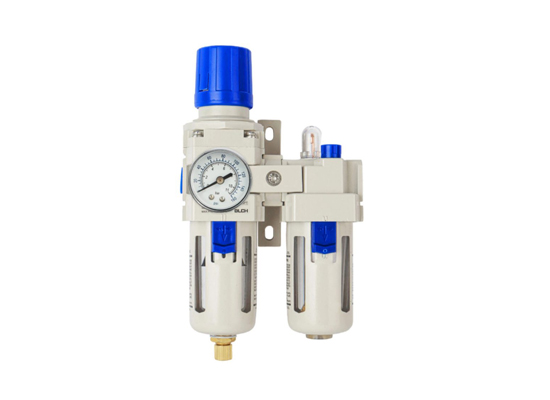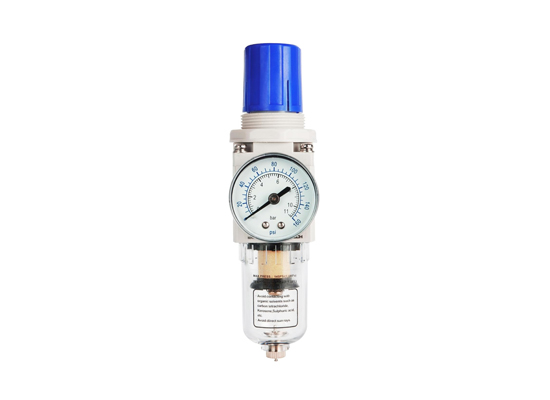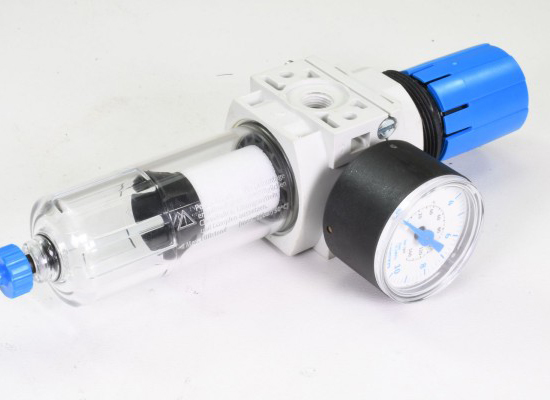Oct 13, 2025
In today's industrial manufacturing, compressed air is as essential as electricity — powering everything from robotic actuators and spray systems to CNC machines and packaging lines.However, the performance and lifespan of these pneumatic systems largely depend on the quality and condition of the compressed air they use.
The FRL (Filter, Regulator, and Lubricator) is a set of air preparation components that treat compressed air before it enters critical pneumatic elements such as cylinders and valves.They are often configured as two-piece (FR) or three-piece (FRL) combinations, designed to clean, regulate, and lubricate the air before it reaches the downstream equipment.
Whether used in automation equipment or pneumatic systems of any kind, FRLs help ensure the highest possible air quality, reduce wear and tear on pneumatic components, and extend service life.In this article, we will explore the key questions about FRLs — what they are, their core functions, how they work, how to select the right model, and where they are most effectively used.

An FRL unit is a compact, modular device used in pneumatic systems to treat compressed air before it reaches valves, cylinders, actuators, or tools.
It ensures that contaminants are removed, air pressure is regulated to the proper level, and a fine mist of lubricant is injected into the air stream.
All of these functions are essential for maintaining system integrity and maximizing the efficiency of downstream components.
FRLs can be purchased as individual modules or as preassembled units.
Single modules provide flexibility and convenience for systems that do not require all three functions, while integrated combinations ensure faster installation and a compact design.

The filter is the first and arguably the most critical component of an FRL unit.
Its main function is to remove solid particles, moisture, and oil mist from the compressed air.
Without proper filtration, contaminants can enter valves and actuators, leading to premature wear, leakage, blockage, and even system failure.
The regulator ensures consistent pneumatic performance by maintaining a steady output pressure, unaffected by fluctuations in input pressure or load demand.
This is especially vital in precision machinery, where unstable pressure can cause erratic actuator movement, extended cycle times, or output defects.
Most regulators use a diaphragm-spring mechanism to adjust pressure.
Continuous and precise regulation not only improves accuracy but also saves energy by preventing excessive air consumption and reducing compressor load and wear.
The lubricator is the final element of the FRL assembly.
It introduces a precisely metered mist of lubricant oil into the air stream, which travels with the compressed air to downstream moving components.
During operation, this mist reduces friction, prevents corrosion, and extends component lifespan.

The FRL’s rated pressure must exceed the system’s maximum working pressure.Typical industrial pneumatic systems operate between 0.4 and 0.8 MPa.
Consider the total air consumption of downstream components.Ensure that the FRL’s port size and flow capacity maintain pressure drop below the recommended value (usually ≤ 0.05 MPa) at maximum load.
Select filtration levels according to the required air quality:
General systems: 40 μm
Precision equipment or valves: ≤ 5 μm
For humid environments, consider adding a secondary filter or an air dryer.
If the environment contains corrosive gases or high temperatures, choose FRLs made of corrosion-resistant or heat-resistant materials such as aluminum alloy or stainless steel.
Match the lubricator type to whether the air system is oil-free or oil-lubricated.
FRLs are usually installed at the equipment air inlet, so they should allow easy filter replacement and oil refilling.Models with automatic drains or differential pressure indicators can improve maintenance efficiency.
If the system has low lubrication requirements, an FR (Filter + Regulator) unit may suffice.
For precise pressure control applications, consider a precision regulator model.
Manufacturing and industrial automation
Automotive and vehicle maintenance
Packaging, printing, and textile industries
Food, beverage, and cleanroom environments
Since FRL units constantly handle oil mist, particles, and moisture in the air, regular maintenance is vital for ensuring long-term stability, efficiency, and reliability of pneumatic systems.
Filter elements become saturated over time, causing pressure drops, reduced airflow, and an increased risk of downstream contamination.
When the pressure drop exceeds 0.05 MPa or airflow decreases noticeably, replace the filter element.
Aging diaphragms or springs can lead to pressure drift or inaccurate readings.
Sudden fluctuations or drops in pressure can damage cylinders or cause quality control failures.
The lubricator supplies essential oil mist to pneumatic components; low oil levels accelerate wear.
Maintain the oil at the proper level and adjust the drip rate as needed.
A well-designed Filter-Regulator-Lubricator (FRL) system is not just a passive accessory — it is an active safeguard and performance enhancer for any pneumatic setup.
By ensuring a supply of clean, stable, and well-lubricated air, an FRL system can:
Extend the lifespan of valves, cylinders, and pneumatic tools
Improve process consistency and output quality
Reduce energy waste through efficient pressure management
Minimize unplanned downtime by preventing internal damage
Lower the total cost of ownership over the long term
The pneumatic FRL unit is the core air preparation unit of an industrial pneumatic system, ensuring stable operation and long service life of downstream actuators through filtration, pressure regulation, and lubrication. Fokca Automation is a manufacturer capable of producing high-quality FRL units, with strong R&D capabilities, comprehensive testing, a rich product line, and extensive industry experience, providing customers with safe, efficient, and reliable pneumatic solutions. If you are interested, feel free to contact us directly!
You May Interest In
Links: www.fescolo.com(Pneumatic)
FOKCA ©1998-2025 All Rights Reserved Sitemap